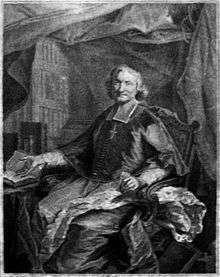Pierre de La Broue
Pierre de La Broue (8 February 1644, Toulouse - 20 September 1720, Mirepoix[1] was a French bishop. He was part of the 'Apellant' movement within Jansenism, which called for the summoning of a church council to discuss the anti-Jansenist papal bull Unigenitus.

Life
From a family of magistrates from Moissac, he chose a career in the church and around 24 went to study in Paris, where he became a doctor of theology. He was also a favourite preacher at the French royal court (according to Madame de Sévigné, he "preached once before the King", at Saint-Germain-en-Laye on 2 February 1679[2]) and heavily linked to Bossuet. He preached the funerary oration for Marie Anne Christine of Bavaria, wife of the dauphin.
In 1679 he was made bishop of Mirepoix and founded a large seminary at Mazères as well as smaller ones at Fanjeaux and Belpech. Whilst bishop he set up a confraternity of pity at Mirepoix and carried out several charitable works. He also aimed to be made deputy to the estates of Languedoc,[3] a request which was never granted. In 1694 he was elected 'mainteneur' of the Acadèmia dels Jòcs Florals, where as a young man he had been praised for a work entitled Adieu aux muses profanes.[4]
With the bishops of Senez (Jean Soanen), Montpellier (Charles-Joachim Colbert de Croissy) and Boulogne (Pierre de Langle), he opposed the bull Unigenitus.[5][6] According to his wishes, La Broue was buried at the seminary in Mazères.
Works
- Oraison funèbre de très haute, très puissante et excellente princesse Marie-Anne-Christine de Bavière, dauphine de France, prononcée à Saint-Denis, le 5 juin 1690, par messire Pierre de La Broüe (1690)
- Catéchisme du diocèse de Mirepoix. Par le commandement de monseigneur l'illustrissime & révérendissime Pierre de La Broüe évêque de Mirepoix, conseiller du Roy en ses conseils (1699)
- Première Lettre pastorale de Mgr La Broüe aux nouveaux réunis de son diocèse (1702)
- Projet de mandement et d'instruction pastorale de M. l'évêque de Mirepoix au sujet de la constitution de N. S. P. le Pape, du 8 septembre 1713 (1714)
- Défense de la grâce efficace par elle-mesme, par feu Mre Pierre de La Brouë (1721)
Notes
- According to Pierre-François Labelle (see last note), he died at "Bellestat, a village in his diocese".
- Louis Monmerqué, Lettres de Madame de Sévigné, 27 February 1679, Hachette, Paris, vol. V, 1862, p. 523.
- Letter 1764 from Bossuet on 30 August 1698, replying visibly to this request
- Axel Duboul, Les Deux Siècles de l'Académie des Jeux floraux, Édouard Privat, Toulouse, vol. 2, 1901, p. 112-113
- François Labelle, Nécrologe des appelans et opposans à la bulle Unigenitus, de l'un et de l'autre sexe, avec des pratiques et des prières à chaque article, s.l., 1755, p. 579-597 : Online text.
- Picot, Michel Joseph, Mémoires pour servir à l'histoire ecclésiastique pendant le dix-huitième siècle, 1717